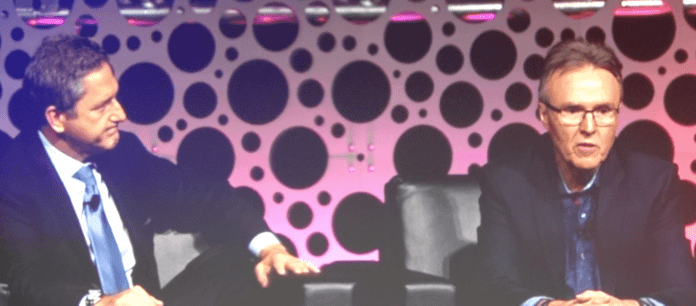‘Connectivity is the foundation of everything we do,’ Liberty Global CEO says
DENVER–Liberty Global CEO Mike Fries, in a keynote presentation during the SCTE Cable-Tec Expo, discussed how traditional cable companies are looking beyond fixed networks to a new age where broadband connectivity can open up new business opportunities in a market colored by increasing competition from more traditional wireless service providers and over-the-top and webscale players.
“It’s not longer just the fixed network,” Fries said in a conversation with Tony Werner, Comcast’s president of technology and product. “Connectivity is the foundation of everything we do,” Fries continued. “We’re heavily invested in mobile. Mobile, for us, is a really important product. If you look at Europe, it’s a quad-play market already. Unlike the U.S., the national incumbent telcos there have national fixed and national wireless coverage. Why wouldn’t you sell that? We’re all in on mobile.”
Liberty Global has launched both MNO and MVNO plays in its various global markets. Similarly, Comcast has an MVNO play that uses Verizon spectrum; and, the Philadelphia-based cable giant is signaling increasing interest in wireless technologies.
“The quad play works,” Fries said. “It reduces churn, it drives engagement, it keeps ARPU hovering where it needs to be. It’s a tough business. It’s a highly promotional, transactional business. The competition is fierce. It’s seamless connectivity going forward and that’s a business we’re squarely in.”
Tony: RDK has been a “magical platform.” it’s open source. “Comcast alone every four minutes of everyday we put a code comment up for review…to go into the RDK platform. THere’s all the pieces that make voice remotes easier. Liberty is a big contributor as well. It really is helping us innovate faster.” originally afraid of VHS, then DirecTV, then came telcos, then OTT. “The OTT is more synergistic. They’ve got great content they want to get to customers.”
In terms of competition beyond just mobile operators, Fries mentioned content providers like Amazon, which can draw on its massive e-commerce and web-hosting business to deliver media and entertainment, as well as Netflix, an OTT player that doesn’t own any network infrastructure but has successfully monetized a service over-the-top of broadband networks.
Given that dynamic, Fries said cable companies have to focus. “One is invest in our core competency, which is our networks. This is the secret sauce for us. It’s the gift that keeps on giving. [And] we fight fire with fire. The whole RDK platform…was a very clear response to what I call the functionality gap. What Netflix showed me was not that they had great movies or great content, but that they had great functionality. We’ve really, I think, closed that functionality gap.”
The RDK platform is an open source reference design kit for creating a common customer premise equipment platform. Companies like Comcast and Liberty Global have leveraged RDK to create a more friendly user interface for cable customers that allows for plug-ins to support streaming services like Netflix, Amazon, Hulu, etc…”Getting Netflix and YouTube into the box…in many instances we’re actually integrating the app into the search functionality. People watch more video, they churn less, they pay us more. Why wouldn’t you put Netflix in the box?”

